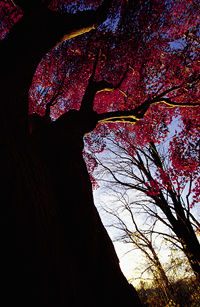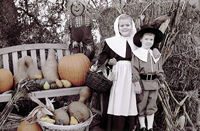Capturing Great Fall Photos
|
Photo opportunities are abundant during the fall. You can shoot great pictures of autumn color, carved pumpkins, or children dressed in an array of Halloween costumes. Days become shorter and the light becomes warmer, which accentuates the changing fall foliage. Besides photographing colorful leaves, look for any subject matter that says "fall," such as pumpkin patches or old barns.
Because there are so many colorful photo opportunities around every corner, don't overlook black-and-white photography. For example, master nature photographer Ansel Adams shot many fall images in black-and-white. There are a lot of great black-and-white films on the market, and if you're shooting digitally, you can experiment by turning color images to black-and-white. If you're traveling to Colorado, Vermont, or any of the other popular fall-color spots, it's a good idea to plan your stay over a course of several days to increase your chances of capturing peak color on film or a memory card. Check with the local chamber of commerce or a local tourism office—they can often give you the best advice on when to visit. Fall color is so pretty, it can make even simple snapshots look good. Nonetheless, you should give your picture-taking a little more thought. Composition is very important, as it is in most photography. You may be tempted to shoot large areas of colorful trees randomly, but don't forget about the smaller picture, which can be as simple as a fallen leaf on a pathway, or the reflection of fall color in a mountain stream. Complementary colors, like yellow leaves against a bright blue sky, create dramatic contrast. Mixing broad views with more intimate close-ups will give your photos a lot of visual variety. Also, be aware of lighting conditions when shooting fall foliage. Because these colors are so bright, they photograph well in a variety of lighting conditions. When it's sunny, do your photography early or late in the day for most dramatic results. Take some pictures of fall leaves backlit by the sun—the leaves will take on a beautiful glow. For even more brilliant color, try holding a polarizing filter in front of your camera's lens if the sun is out. This filter must be used at a 90° angle to the sun to polarize the sun's rays. You can get more saturated blue skies, and this filter will remove surface reflections from wet leaves for even richer color. Overcast skies also provide subtle lighting with no shadows, resulting in fall colors that take on soft, muted tones. You may want to concentrate on shooting nature close-ups and exclude the sky from your pictures on gray days like these, as the sky will appear too bright and washed-out in your photos. Also, large areas of blanched-out skies can fool your compact camera's meter, and you'll wind up with a lot of dark, underexposed pictures. Don't put your camera away during inclement weather, except during a heavy downpour or a blizzard. You can get some appealing photos during a light rain or snowfall—the colors of fall leaves become very saturated when wet, and a light dusting of snow can lend a frosty texture to them. When you're out in bad weather, keep your point-and-shoot camera inside your jacket or another warm place until you're ready to use it. A plastic bag will keep your camera dry, but if it gets wet, dry it off immediately. If you're going to a very wet area, consider getting a single-use waterproof camera, or even a compact camera that's splashproof. These cameras operate well under most inclement-weather conditions, as long as they're not submerged. |
- Log in or register to post comments



















































